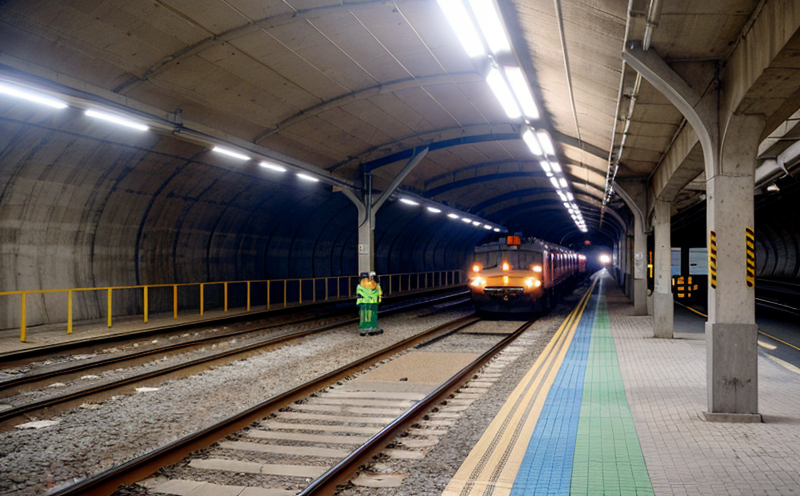EN 1998 Seismic Resistance Testing of Railway Bridges
The European Standard EN 1998:2016 provides a framework for the structural design and assessment of railway bridges, emphasizing their seismic resistance. This standard is crucial in regions prone to earthquakes where infrastructure integrity directly impacts public safety and operational continuity.
Seismic resistance testing evaluates how well a bridge can withstand ground shaking forces without sustaining critical damage or failure. The test involves subjecting model elements representative of the bridge's structural components to controlled seismic loading. This process assesses the bridge’s capacity to maintain its integrity under extreme conditions, ensuring that it remains safe and functional post-seismic events.
The testing procedure is comprehensive, incorporating various phases including preliminary design checks, detailed analysis, prototype development, and rigorous testing. The primary goal is to determine whether the bridge can resist the specified seismic forces without compromising structural stability or requiring extensive repairs.
For railway bridges, this involves examining elements such as piers, abutments, deck structures, and substructures. Real-world usage notes suggest that many modern bridges incorporate advanced materials and innovative designs to enhance their resilience against earthquakes. These tests help verify if these enhancements are effective in practice.
- Prototype Development: Creating scaled-down models of bridge components to accurately simulate full-scale behavior under seismic conditions.
- Instrumentation: Deploying sensors and data collection equipment during testing to monitor structural responses.
- Data Analysis: Utilizing sophisticated software tools to analyze collected data, identifying potential weaknesses or areas for improvement.
The EN 1998 standard ensures that all tests are conducted in accordance with international best practices. Compliance with this regulation is essential for railway infrastructure owners and operators committed to maintaining high standards of safety and reliability. By adhering to these guidelines, stakeholders can ensure their assets meet stringent performance criteria set forth by authoritative bodies.
It is important to note that while the focus here is on EN 1998 seismic resistance testing for railway bridges, similar principles apply across various transportation sectors including tunnels and stations. These tests play a vital role in safeguarding critical infrastructure against natural hazards, thereby protecting both lives and investments.
In conclusion, implementing EN 1998 seismic resistance testing is not just about meeting regulatory requirements; it's an investment in long-term safety and resilience of railway bridges. Through meticulous planning and execution, engineers can ensure that these vital structures remain robust even under the most challenging environmental conditions.
Benefits
The implementation of EN 1998 seismic resistance testing offers numerous advantages to stakeholders involved in railway infrastructure. Firstly, it enhances public safety by ensuring that bridges can withstand severe earthquakes without collapsing or causing injuries. Secondly, this testing promotes operational continuity as damaged structures are identified early, allowing for timely repairs and maintenance.
From an economic perspective, regular seismic resistance assessments help prevent costly downtime associated with structural failures during major incidents. Additionally, compliance with international standards like EN 1998 demonstrates a commitment to excellence, which can attract investors and foster trust among the public.
In terms of environmental impact, resilient bridges contribute positively by minimizing disruption caused by repeated closures or reconstruction efforts following disasters. Moreover, these tests encourage innovation in materials science and engineering practices, leading to more sustainable solutions for future projects.
Why Choose This Test
Selecting EN 1998 seismic resistance testing is the prudent choice for several reasons. Primarily, it aligns with global best practices established by renowned standards organizations. Secondly, this method offers a systematic approach to evaluating structural integrity under extreme conditions.
Moreover, choosing this test ensures that all aspects of bridge design and construction are thoroughly examined, reducing the risk of unforeseen issues arising later. Lastly, adherence to these stringent criteria helps build confidence among decision-makers regarding the reliability and robustness of railway bridges.
Quality and Reliability Assurance
- Consistent Performance: Ensures that each test adheres strictly to predefined parameters, providing reliable results every time.
- Sophisticated Analysis: Leverages advanced analytical techniques to interpret complex data sets accurately.
- Comprehensive Documentation: Maintains thorough records throughout the entire testing process for future reference.
- Informed Decisions: Provides actionable insights based on test outcomes, guiding strategic planning and execution.





